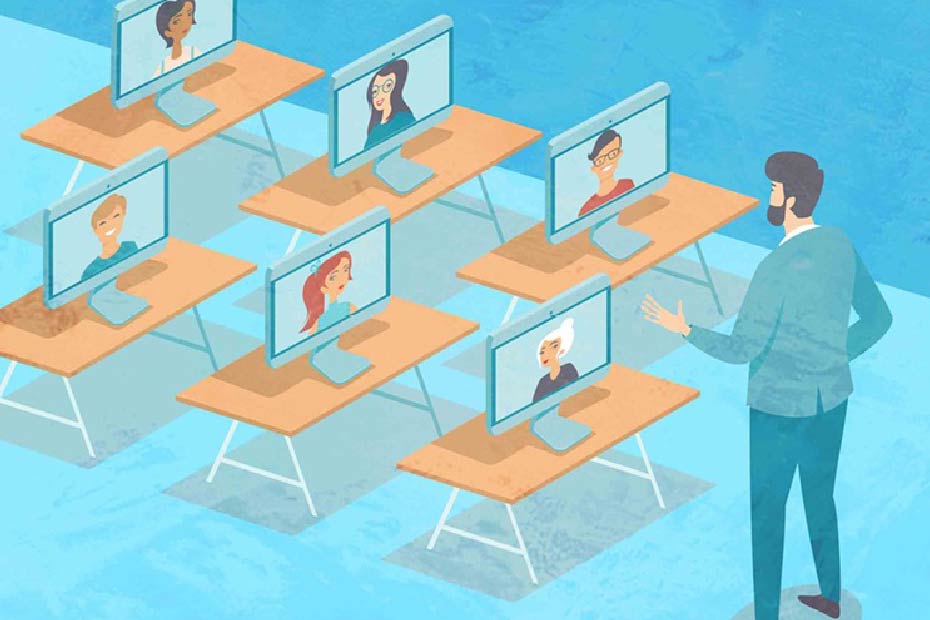Published October 26, 2020 • 13 Min Read
COVID-19 triggered a mass experiment in online education that will have a lasting impact on how and where Canadians learn. The abrupt change poses a fresh challenge for a Canadian higher-education system that was already preparing for an economic future that might look very different. Over the span of a few weeks in March, Canada’s post-secondary institutions moved more than two million students online. The swift transition provided some early lessons: most students can learn from anywhere, and educational institutions have the ability to transform quickly. As the urgency of managing the crisis shifts to securing Canada’s economic recovery, students looking to gain the skills to compete in the post-COVID world will demand more from digital education. Institutions should seize on this moment to give students and life-long learners greater flexibility in where, when and how they learn. The higher-education system is about to become more competitive. Nearly every post-secondary institution on the planet has just made significant investments in online tools and methods. For Canada to remain a global education leader that continues to attract the world’s brightest, our institutions will need to differentiate themselves. This starts with cultivating the scale needed to make online leaning profitable; collaborations across the sector could give students more choices and specializations. The next step requires an inclusive approach to alternative learning – either experiential learning or micro-credentials — that gives students flexibility in how and where they obtain academic credits. At the same time, educators will need to integrate the tools of augmented reality and machine learning to personalize education.
Key Findings
Nearly 1.6 billion learners have been affected by national school closures Amid the pandemic, 91 per cent of the world’s students were displaced from the classroom. In Canada, more than seven million students had to shift their learning style: 5.1 million in K-12, 1.2 million in universities, and 800,000 in colleges and polytechnics. The 540,000 students completing post-secondary education this year likely completed their programs remotely. Canadian institutions historically lacked the resources or expertise to fully develop online learning About 16 per cent of university and 12 per cent of college students learned primarily online in 2019, while more than one-third of undergraduates had at least one course with blended learning. Despite wider usage of online tools, funding and staffing issues have hampered digital education at half of universities and colleges, more so among smaller institutions. Canada’s advantage in international student attraction is at risk New international student permits dropped by 45% in March (year-over-year). Ongoing travel restrictions and visa-processing delays will likely stall international student arrivals in the coming months. These students pay about $6 billion in tuition alone to universities and colleges each year. Digital spending comprised only 2.5% of global education expenditures pre-lockdown Despite a 14x increase in EdTech venture capital since 2010, digital spending remains a small fraction of education budgets. Pre-crisis forecasts expected spending to reach 4.3% of budgets by 2025. Investment activity has been concentrated in China and the United States. Last year they attracted 52 per cent and 33 per cent, respectively, of digital education investments.Key Questions
1. Will the explosion of remote-based learning lead to more options for students?
The simple answer is ‘yes.’ The longer schools remain unable to teach the way they used to, the more sticky remote-based learning will become. Students and educators will want to retain the experiences and tools they like. Post-pandemic, institutions can expect to have a tougher time attracting students. With students realizing they can learn from anywhere, institutions will need to show why their campus experience is different. Online education has the potential to be a great leveler among institutions. Schools of any size, location or level can provide unique offerings through online education: it is borderless, scalable and untethered to the traditional academic calendar. At the same time, students are looking for job-ready skills for a fast-changing labour market. Online non-degree granting institutions, such as edX, Coursera and Udemy, can create and scale new, skills-focused courses faster than universities. What if a student could get credit for them? Self-directed programs — where students choose from a menu of micro-credentials; online, on-campus or blended learning; and courses from a variety of institutions – may become an option in the not-too-distant future. We’ll need to expand the traditional boundaries of higher education, with accredited institutions giving more credit for learning in all forms. While some universities are recognizing Massive Open Online Courses (or MOOCs) in their admissions practices, the real friction point will be within the credit transfer system. One example of more flexible learning is South Korea’s Academic Credit Bank (ACBS), where students can complete studies across institutions, based on their own pace and preferences; once they amass sufficient core, general and elective credits, the ACBS will certify their record and the Ministry of Education can issue a degree (without attachment to any individual institution). Such an experience would give students plenty of options in designing their own learning.2. Which learners are most vulnerable to disruption?
As online education requires both personal digital devices and strong internet connections, students that lack access to either are most vulnerable to losing out. About one in four Canadian households in lower-income categories use smartphones as their primary internet access. Roughly 10 per cent of households — mostly in rural areas — lack reliable broadband internet. Indigenous students are over-represented in these categories. And for students with accessibility concerns, institutions may need to provide custom digital tools to ensure continuity in their learning. The current ambiguity of when schools can return to normal operations will influence how some students make decisions with long-term impacts. In any other year, about 40,000 high school students will drop out of studies. This year, we are likely to see higher numbers, as nearly 300,000 are at higher risk of not completing a diploma due to economic insecurity. For those entering university, college and trades programs this year, orientation is likely to be a remote experience too. Many schools are considering whether to change the timing of first-year courses, including front-loading online-ready courses to the fall, even those that previously had strict pre-requisites. Education consultant Alex Usher has called on Canadian universities to collaborate on a common, online first-year curriculum for 2020 entrants. Given uncertainties around the student experience in 2020/2021, one in four students is considering a gap year or leave of absence, according to recent Ivy Research Council surveys.3. Will online learning in Canada still appeal to international students?
This remains to be seen, and is a critical question: international students are big business for our schools. If they are unable to enter Canada, we will need to find new ways of marketing a Canadian credential to non-residents. At the start of 2020, over 640,000 foreign nationals held study permits; while at least 293,000 new permits were issued in 2019 alone, across all learning levels. In post-secondary, the international student population has doubled in the last five years to 500,000, nearly one in four students, contributing about $22 billion in GDP and about 11,000 new permanent residents annually. Amid lockdowns, new student arrivals dropped in Q1 2020, while severe declines should be expected for the foreseeable future. To stem enrolment declines, the federal government is permitting new international students to begin their programs in their home country, complete up to 50 per cent of their program via distance learning, and assuring access to post-graduate work permits. However, the shift to online learning greatly alters an international student’s experience if they’re unable to reside in Canada during their studies and make connections, while still paying nearly double the tuition of domestic students. About 26 per cent of study permit holders (or 168,000) come from countries with the most aggressive online censorship regimes. Access to Canadian education resources cannot be guaranteed for this group. Colleges and universities should prepare for a high degree of enrolment deferrals to Winter 2021 or later, and the resulting need to restructure course prerequisites and in-year bridging programs. Colleges that offer career-transition programs for international students – which have experienced enormous growth in the previous 15 years — could be greatly impacted for two reasons. First, online learning won’t provide the hands-on, workplace-based learning that’s integral for these mostly health care workers or tradespeople. Second, uncertainty of the job market in Canada will dissuade many from taking the risk of relocating.4. Can job-ready skills be cultivated through online learning?
Without question, learning remotely develops skills that employers demand. It requires students to manage their time effectively, strengthen their written communications and foster a digital aptitude to work alongside technology. And right now, the biggest lessons students are gaining aren’t academic; it’s about being resilient and adaptive. These will be key attributes for their future. However, the online environment can fall short in developing socio-emotional skills like active listening, speaking and critical thinking skills. RBC’s 2018 report, Humans Wanted, concluded that these skills will be in the highest demand by Canadian employers. Online instruction requires a different pedagogy than in-person learning to achieve the same outcomes, and to develop these human skills it needs to support various forms of social interaction. Athabasca University, Canada’s largest online-only school, doesn’t try to replicate the classroom in digital form. But it has taken a learner-centered approach to skills development, encouraging peer-to-peer interactions through team-based learning and virtual study groups. Athabasca’s April enrolment grew by 12.3 per cent for undergraduate and 10.7 per cent for graduate studies; an early signal of student preferences in the COVID-19 era. Work integrated learning (WIL) has become a part of studies for nearly 60 per cent of post-secondary students, as it cultivates workplace skills and professional networks that can facilitate smoother transitions to employment. The lockdown has made these opportunities impossible for many employers; about one-third of students have lost or delayed their WIL placement. Virtual WIL has been an alternative for some students, and this format may stick around. Vancouver-based Riipen Networks, which creates short-term, virtual work projects for students, has now engaged with 45,000 students across 200 schools in North America. For coops, Canadian university administrators (via CEWIL) have ensured that students will receive credit for such Virtual WIL projects.5. Can learning on a massive scale become more personalized?
If it can’t, students are more likely to disengage. While online learning requires scale to be profitable – such as classes of hundreds or thousands of students – it must offer learners personalized experiences. The market for EdTech is as hot as it’s ever been, with VC activity reaching US$3 billion in Q1 2020, or about the entire value of deals in all of 2016. In highest demand are the tools that promise to make the digital experience unique for each learner. Augmented and virtual reality are being used to replace live subjects (e.g. nursing, dental) or to provide access to expensive test equipment (e.g. machine repair, construction). These tools allow students to practice and explore in new environments without risk of harm or error. EdTech market watcher HolonIQ is most optimistic on AR/VR, predicting a 7x increase in spending by 2025. Adapted for smartphones, these tools could usher in a new wave of remote learning including to virtual laboratories and situation-based learning that may be impossible in a physical environment. Artificial intelligence will be a huge disruptor for education in the 2020s. While chat-bot tutors might reduce demands on faculty and real-time translators could break down language barriers, machine learning has the potential to completely alter student assessments. By understanding and documenting a student’s progress through digital-based learning, AI can develop customized learning plans. Applied broadly, these tools could eliminate aged-based grade levels in K-12 or change course pre-requisites to skill requirements for progression in post-secondary. The infrastructure of education may be transformed too by blockchain technology, where credentials could be instantly verified. Such a system could lead to simplified credit transfers between institutions and stacking of credentials. This could open the possibility of a personal skills registry, where one’s skills, credentials and ongoing learning achievements are certified and accessible.6. Are post-secondary institutions at an inflection point for their business model?
COVID-19 may precipitate the largest pivot in the delivery of higher education we’ve ever seen. Enrolment and revenue declines, combined with increased costs in technology, will force institutions to innovate. Those that can’t will be left behind. First, we cannot ignore the transformation schools made to get over two million learners online in March. This is a major achievement, considering nearly two-thirds of Canadian post-secondary institutions cited faculty resistance as the main barrier to providing more online course options prior to COVID-19. Many educators believed online delivery limited outcomes, primarily that students were unable to self-regulate their learning. Any of these misgivings have given way – at least temporarily – to emergency measures, and institutions have been making strides on technology and course design. Second, the institutions that had previously invested in online education are best positioned to pivot their operations. Université de Laval initiated its own learning platform in the late-2000s, through the Laval Academy of Digital Transformation; prior to COVID, 71 per cent of its courses did not have an online component, but by end of March 95 per cent of its courses transitioned to the online platform. At the University of Windsor, the Office of Open Learning quickly deployed resources and training for faculty to go “online in a hurry.” Bite-sized training through templates, tools, as well as blogs and podcasts, were shared across institutions. The University of Waterloo has hired over 300 summer students to work with faculty to transition courses online for fall 2020. Finally, we will see a breakdown of the artificial barriers between Canada’s higher-education institutions. Many of which are already facing pressures to reduce costs, amid soaring public debts and expected enrolment declines. Stronger collaborations between universities and colleges will be needed to reduce duplication of and increase access to online resources. Sharing of course and learning materials is already practiced by the Maple League of schools in Atlantic Canada, the Tri-University Group in southern Ontario, and through Education City in Ottawa. Going forward, these types of partnerships will be necessary to coordinate online course offerings that maximize student options and experiences.What we’re watching:
Canada’s higher education system has an opportunity to transform, to become a global player in online education, even in a post-pandemic world. To differentiate itself, things to consider:- Collaborations among universities, colleges and polytechnics on common digital learning platforms, as well as shared online curricula.
- Proposals to modernize the credit transfer system that recognize micro-credentials and experiential learning completions towards a diploma or degree.
- Changes to the traditional academic calendar, with higher enrolments in spring/summer terms, as well as rolling start dates for online students.
- New forms of engagement with international students that may include more in-country presence of Canadian institutions.
- Greater demand for course designers to develop pedagogy that adds AR/VR and machine learning to create personalized student experiences.
This article is intended as general information only and is not to be relied upon as constituting legal, financial or other professional advice. A professional advisor should be consulted regarding your specific situation. Information presented is believed to be factual and up-to-date but we do not guarantee its accuracy and it should not be regarded as a complete analysis of the subjects discussed. All expressions of opinion reflect the judgment of the authors as of the date of publication and are subject to change. No endorsement of any third parties or their advice, opinions, information, products or services is expressly given or implied by Royal Bank of Canada or any of its affiliates.
Share This Article






